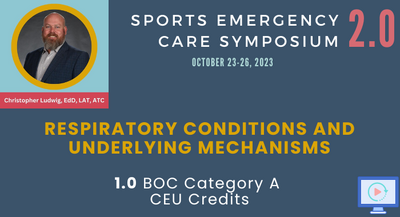Course Info (BOC Domains of Athletic Training; Presentation Description; Learning Objectives; Clinical Practice Gap Statement; Clinical Bottom Line; Summary Conclusions)
BOC Domains of Athletic Training:
- Domain I - Injury and Illness Prevention and Wellness Promotion
- Domain II - Clinical Evaluation and Diagnosis
- Domain Ill - Critical Incident Management
- Domain IV - Therapeutic Interventions
Presentation Description:
This presentation delves into the intricacies of various respiratory conditions and their underlying mechanisms. We'll start by analyzing pneumonia, understanding its pathophysiology, symptoms, and management goals. Next, we'll explore pulmonary embolisms, spontaneous pneumothorax, and hyperventilation, unraveling their complexities and discussing effective management strategies. Additionally, we'll cover a range of respiratory infections and conditions commonly encountered in athletic training settings, equipping you with the knowledge needed to address them promptly and effectively.
Learning Objectives:
- Analyze the underlying mechanisms, symptoms, and goals for managing patients with pneumonia.
- Evaluate the pathophysiology, symptomatology, and management objectives for individuals with pulmonary embolisms.
- Review the causes, symptoms, and management strategies for spontaneous pneumothorax cases.
- Study the pathophysiology, symptomatology, and management targets for patients experiencing hyperventilation.
- Evaluate the pathophysiology, symptoms, and management goals of various respiratory infections and conditions encountered in athletic training settings.
Clinical Practice Gap Statement:
There is a discernible gap in the expertise of athletic trainers concerning the recognition and understanding of the foundational elements of respiratory conditions. This knowledge shortfall can result in a lag in both diagnosing and managing respiratory issues, thereby jeopardizing the health and safety of athletes. Bridging this knowledge gap is crucial for athletic trainers to deliver all-encompassing care and facilitate a safe reintegration of athletes into their sports activities.
Clinical Bottom Line Statement:
Within the context of sports emergency medicine, a profound understanding of the complex pathophysiology and effective management techniques for respiratory conditions is indispensable. This presentation is designed to close the existing knowledge gap, offering a comprehensive look into the diverse range of respiratory conditions. This newly acquired knowledge will equip athletic trainers with the tools necessary for confident assessment, accurate diagnosis, and adept management, thereby enhancing athlete care and recovery.
Summary Conclusion Statements:
- Acquiring in-depth knowledge of respiratory conditions is crucial for holistic athlete care.
- Mastery over the foundational elements of respiratory conditions is instrumental for effective intervention and management.
- This presentation serves as an educational tool, preparing athletic trainers to confront and manage respiratory challenges proficiently.


